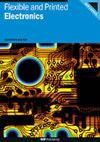空穴传输材料与喷墨打印qled的研究进展
IF 3.2
4区 工程技术
Q3 MATERIALS SCIENCE, MULTIDISCIPLINARY
引用次数: 1
摘要
量子点发光二极管(QLED)由于其独特的优点,如光谱可调、高色饱和度、与低成本喷墨打印(IJP)技术的兼容性以及在大面积全色像素化显示器中的应用潜力,吸引了人们的极大兴趣。到目前为止,红色、绿色和蓝色QLED的效率和寿命已经显著提高,其中空穴传输材料(HTM)在决定器件性能方面发挥着关键作用。在这篇综述中,我们重点总结了QLED中各种类型的HTM,包括小型有机材料、聚合物、可交联材料和无机p型半导体,并对它们的性质如电荷载流子迁移率、热稳定性和结构配置进行了综述。讨论了这些特性对器件性能的显著影响,这将有助于理解器件物理,提高QLED的性能和可靠性。此外,还综述了用于QLED制造的IJP的发展以及IJP对量子点成膜性能的影响因素,以期为QLED显示器的继续发展提供指导。本文章由计算机程序翻译,如有差异,请以英文原文为准。
Recent progress in hole-transporting materials and inkjet-printing QLEDs
Quantum dot light-emitting diodes (QLEDs) have attracted a great deal of interests due to their unique advantages such as tunable spectrum, high color saturation, compatibility with low-cost inkjet-printing (IJP) technology and potential for use in large-area full-color pixelated display. To date, the efficiency and lifetime of red, green, and blue QLEDs have been significantly improved, in which hole-transporting materials (HTMs) play the key role in determining the device performance. In this review, we highlight to summarize the diverse types of HTMs in QLEDs, including small-organic materials, polymers, crosslinkable materials and inorganic p-type semiconductors, and their properties such as charge carrier mobility, thermal stability, and structural configuration are also reviewed. The significant effects of these properties on device performances are discussed, which would help to understand device physics and improve their performances and reliability of QLEDs. In addition, the development of IJP for QLEDs fabrication and the influence factors of IJP on quantum dot film-forming property are also reviewed, in an effort to provide guidance to continue the advancement of QLED displays.
求助全文
通过发布文献求助,成功后即可免费获取论文全文。
去求助
来源期刊

Flexible and Printed Electronics
MATERIALS SCIENCE, MULTIDISCIPLINARY-
CiteScore
4.80
自引率
9.70%
发文量
101
期刊介绍:
Flexible and Printed Electronics is a multidisciplinary journal publishing cutting edge research articles on electronics that can be either flexible, plastic, stretchable, conformable or printed. Research related to electronic materials, manufacturing techniques, components or systems which meets any one (or more) of the above criteria is suitable for publication in the journal. Subjects included in the journal range from flexible materials and printing techniques, design or modelling of electrical systems and components, advanced fabrication methods and bioelectronics, to the properties of devices and end user applications.
 求助内容:
求助内容: 应助结果提醒方式:
应助结果提醒方式:


